How to have better sales calls and close more deals

Enterprise Account Executive

Tags
Share
In a client facing role like Sales and Customer Success, daily calls are the lifeblood of the business. From prospecting to discovery, solidifying a partnership through account management, quality time with clients are essential to success.
Some calls can be more challenging, some might not land a further conversation or win the deal, but honing the skills of a successful call is never to be underestimated.
As an Enterprise Account Executive here at Dialpad, I'll share some tips I've learned along the way, as well as some helpful technology that makes me and my team more successful on a daily basis.
Let's get started with an overview of some of the fundamental types of calls:
5 types of sales calls
You can group sales calls into five main categories, though the types of calls you make largely depend on your business and industry. In today’s business environment, most of these will be virtual and take place on the phone or over a video meeting. But don’t let that deter you, technology innovations empower sales reps to be more efficient and engaged during the process.
For instance, in my role here at Dialpad, I lead many client discovery and product presentation calls. But a distribution company’s sales team may focus more on pricing and negotiation calls.
1. Prospecting
Cold calling is one of the tried-and-true sales techniques that relies on a lot of time on the phone placing outbound calls. These calls provide a salesperson with the chance to introduce yourself and your company, gather information about your prospect, and evaluate interest in further conversations.
Cold calls are unsolicited, which means you found your leads’ information through LinkedIn or from a list provided by your Marketing team—you don’t have a referral to lean on and haven’t had a chance to build trust with the lead. To succeed with this technique, you need to be confident and concise in your sales pitch, and quick at building rapport.
Having a power dialer feature in your phone system is ideal for cold calling since it’ll automatically dial the next number on your outreach list as soon as a sales rep ends a call. They’re a great way to save time and get more at-bats.
Another way to save time and be more efficient is to leverage a “voicemail drop.” Here at Dialpad, we get to use our own unified communications platform, which enables our teams to work at higher velocity while maintaining enthusiasm and consistency. How it works: as a rep making multiple cold calls, you can simply “drop” in a pre-recorded message as soon as you hit a prospect’s voicemail greeting:
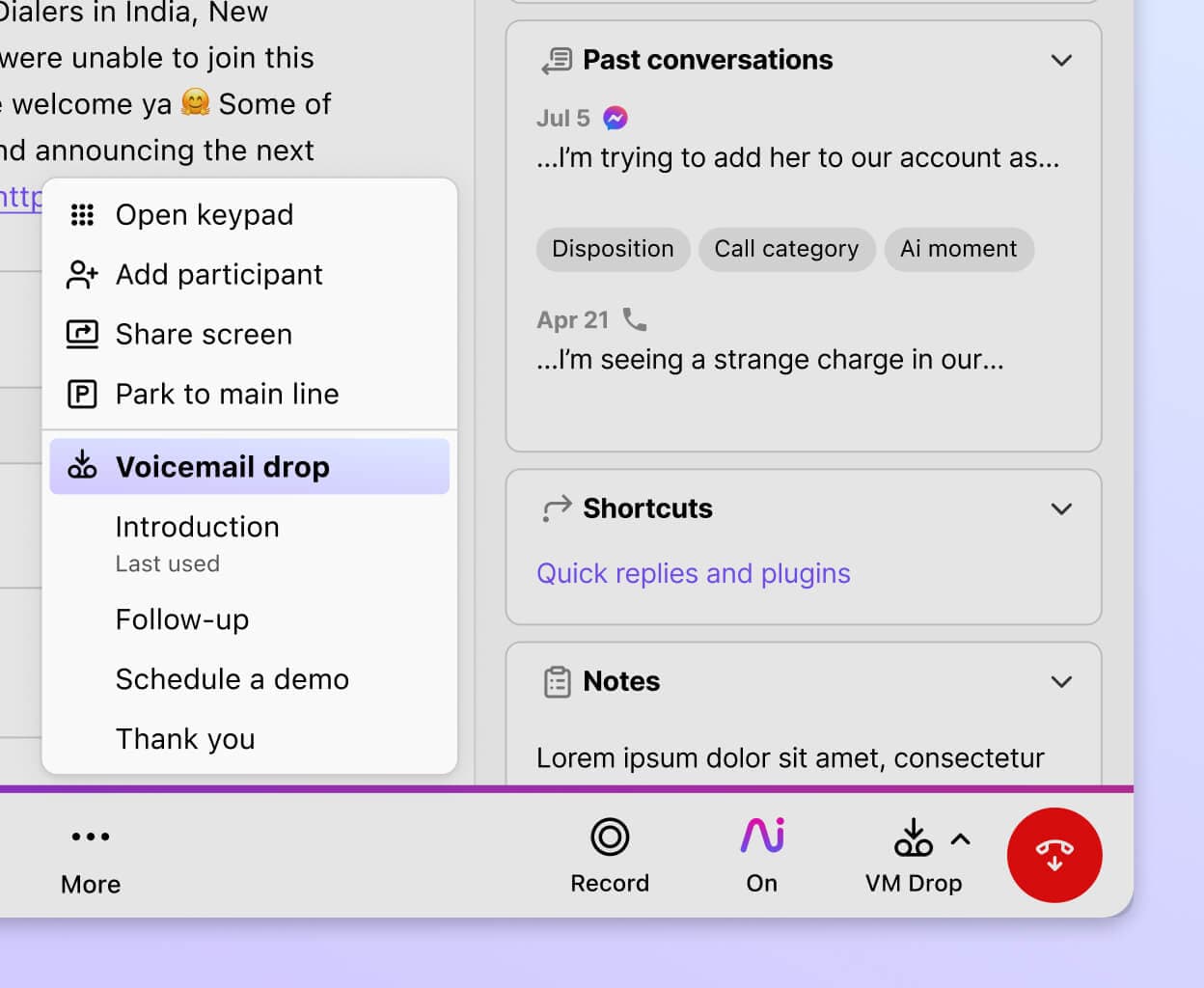
This way, salespeople don’t have to waste time reciting the same message over and over—what used to take minutes at a time now takes literally a second. It doesn’t sound like much, but it really adds up over the course of a long day and week of prospecting!
2. Discovery
Discovery calls are often when the ideas of a partnership start to take shape. These are essential opportunities to learn more about your potential customer’s current challenges, future goals, and desired outcomes from their evaluation of your product or service.
These calls are also a great time to bring your team to the table as well; help understand unique technical needs, draw alignment with multiple stakeholders and ensure the preparation for the next call is cohesive. Potential customers rely on these calls to get a better understanding of how your product or service could be a good fit for them and help them achieve their goals in the evaluation.
To have a successful discovery call, my best sales tip here is to do your homework. Have a solid baseline understanding of your prospect’s industry and business, your product’s value for them, and most importantly, have a list of questions ready so that you can make the best use of their (and your) time—trust me, it’ll fly by once you’re on the call.
In addition to preparation, active engagement and listening during a discovery call is key. A prospect might be sharing a lot of specific details, referencing other stakeholders, and articulating elements of the evaluation that will be essential to the partnership. Here at Dialpad, we’re fortunate to leverage our artificial intelligence technology for real-time transcription, note taking and recognized action items:

No longer do we have to be distracted with note taking during a call, we can actively focus and know that all of the details are being automatically captured, transcribed and stored in our CRM.
3. Sales presentations
The stage is set and it’s time to put what we’ve learned into action. The sales presentation, or product demo, is where you as the sales rep have a chance to shine when it comes to presenting to your potential customer.
Taking the information gathered from research and discovery calls, it’s time to bring the teams together to present the solution and how it will address the customer’s needs and goals.
Here at Dialpad, bringing everyone together in a single virtual room is one of the easiest aspects of meeting customers where they’re at. I just use Dialpad to host a virtual meeting and screen share with slides and a live product demonstration:
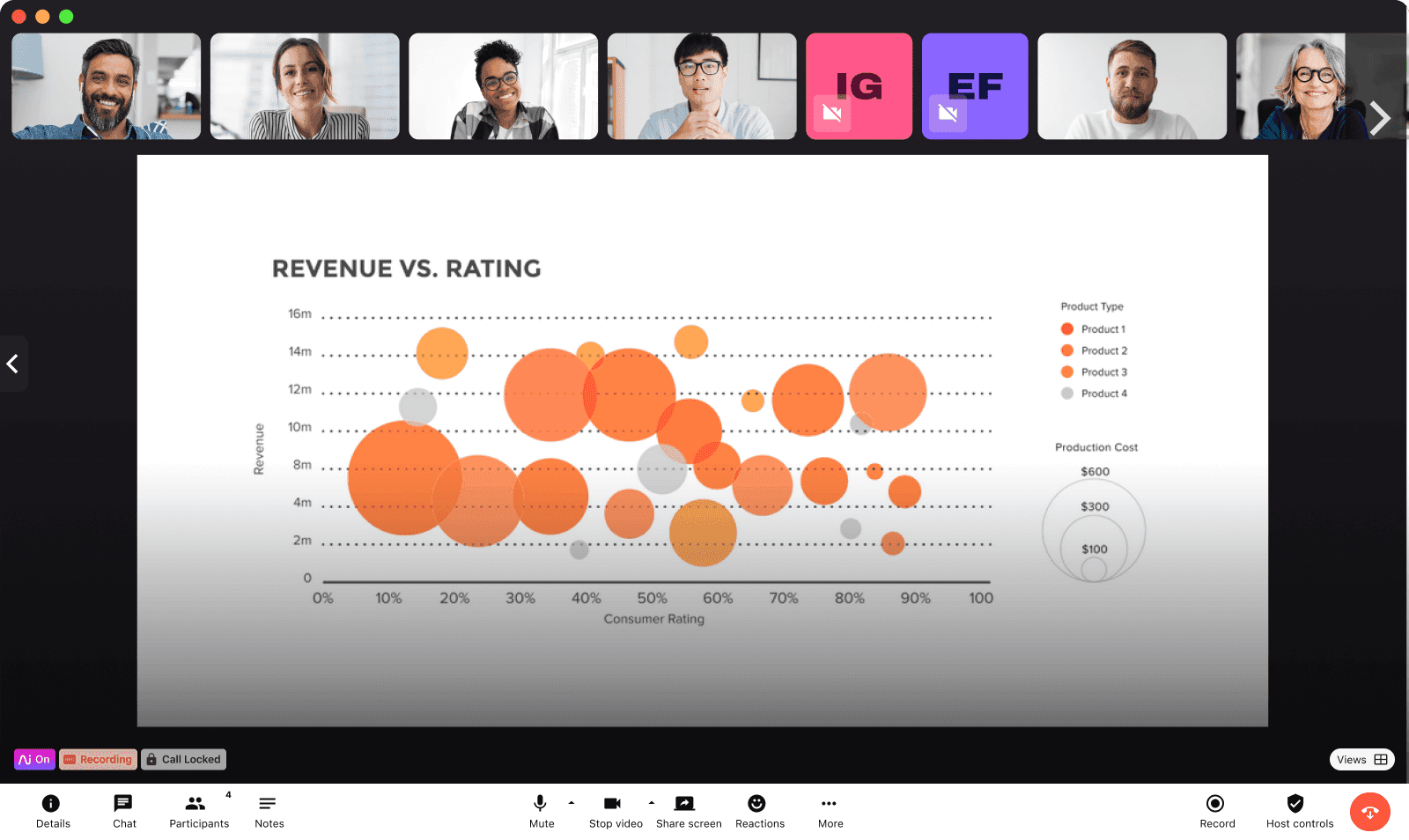
Prospects love it too because they don’t have to download any software—I just send them a meeting link and they can join from their web browser:

(And of course, our trusted Dialpad Ai is present in these meetings as well, with automated transcription for all to see so no one misses important information or details of the presentation.)
4. Partnership alignment
Alignment calls are chances for both parties to review the details presented and discuss the next stages of a partnership. These may include addressing technical considerations, presenting pricing, establishing executive introductions, and even discussion of the purchase process.
Being prepared and well presented should not be forgotten here! Some people on the call may be familiar with you, your team, or your product already—but others might be joining the call for the first time. Stakeholders from Finance and Procurement are often brought into the conversations later during alignment calls.
Don’t be afraid to ask questions and dig deeper to get a full understanding of what the prospect needs from your product—during a sales cycle we’re always gathering more (and sometimes new) information. These discussions often unearth really valuable information that you didn’t expect.
I can’t emphasize enough the value of Dialpad Ai here because it handles the call transcription and note-taking—and even emails me the call summary afterward—so that I can review all these details later if I need to:
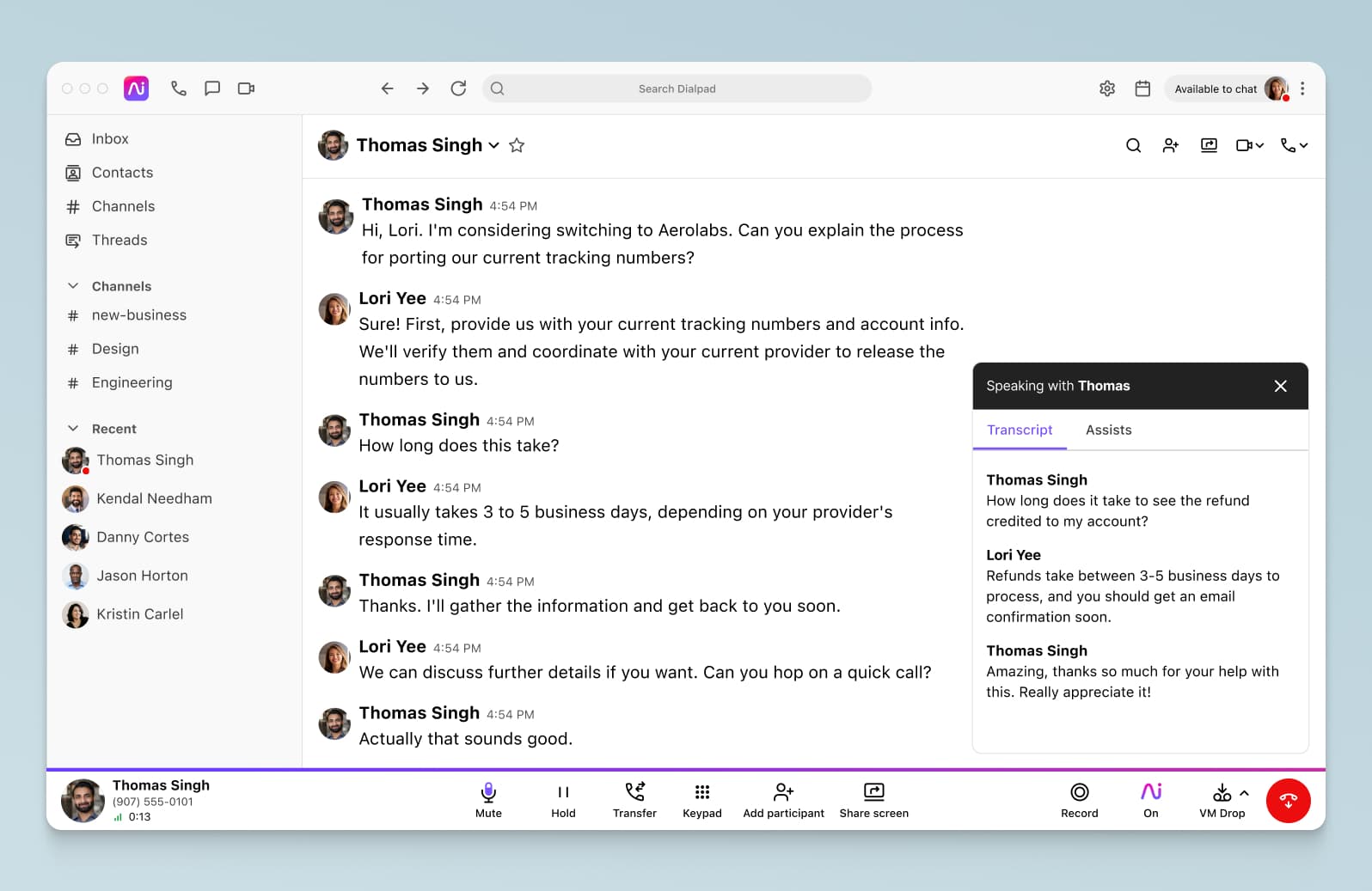
5. Account management
You might think closing a deal is where your job ends. It isn’t. It’s common for sales reps to work with customer success and account managers to develop a new customer’s account.
The aim of account management is to build a lasting relationship with your customer. That means giving them the best possible experience while anticipating their current and future needs. Each member of the account management team should be clearly introduced when meeting a new customer. The client account may now be in the hands of a new team but it’s an ongoing process to maintain and build the relationship—it might even turn into additional sales and referrals in the future.
Done well, account management increases customer retention, reduces churn, and ultimately boosts revenue.
Now that we’ve covered the basic types of calls, here are some tips on how to prepare for them.
How to prepare for a sales call: A 3-step process
As any sales coaching expert will tell you, before making sales calls, preparation is key. This applies whether it’s your first call to a prospect, a follow-up call, or when you close the deal.
Preparation can help you overcome most sales call objections and make sure you have all the knowledge you need to move a deal toward the finish line—plus it also gives you the confidence to pivot quickly from your original talking points and deal with any tricky questions that crop up.
Step 1: Research your potential customer’s background and history
The first step in the sales call process is researching your prospect’s background. This includes their company, position, tenure, location, activities, and history with your company (if any). For my research, I look at:
The prospect's company website (paying particular attention to details about the company, their leadership and recent news)
Their LinkedIn profile and social media pages
Public news about the company
Any past interactions recorded in our CRM
👉 Fun fact:
Dialpad integrates with a variety of CRMs, like Salesforce, HubSpot, Zoho CRM, and more!
Step 2: Gather information that addresses the prospect’s needs
Now, it’s time to play a little chess. It’s important to understand your prospect’s challenges and your product’s or service’s value proposition (basically how you could help them).
As an example, let’s look at one of Dialpad's customers, the activewear brand Outdoor Voices. One of their key challenges was struggling with disparate tools that didn't provide a good customer experience for clients calling their stores. They needed a centralized system that was scalable and easy to manage.
That information formed the basis of our proposal as we asked, how could we solve their needs? Eventually, we landed on addressing these pain points:
Through the deployment of Dialpad’s TrueCaaS platform, Outdoor Voices could give their customers a consistent, unified experience on all their channels. Their teams could also easily add or remove numbers to meet their growing business needs..
By showing the prospect you’re thinking about their specific problems, you’ll have a much stronger proposal that’s more likely to resonate, and it shows that you’ve been paying attention to what they are asking for!
Step 3: Prepare to handle objections
In any sales conversation, you’re likely to face an objection or two during the process. As a salesperson, it’s important to go in prepared for the phone call and arm yourself with the answers to those expected objections (i.e. price considerations, selecting the right product, technical considerations). Be ready with the knowledge and resources to answer what you can on the call, but also know when there may be items to revisit after consultation with your team.
We can prepare for a call as much as possible, but there will often be a unique question asked or objection shared. Sometimes it’s an easy answer and sometimes it’s a curveball.
This is where Dialpad’s Ai Agent Assist is super helpful. It can automatically search through our knowledge base, even including unstructured sources of data like past customer calls, to pull up a wide variety of resources for us in real-time. In this example, a technical question such as “How can I change the hold music” delivers the answers on screen for a quick and factual response based on our Help Center knowledge base:
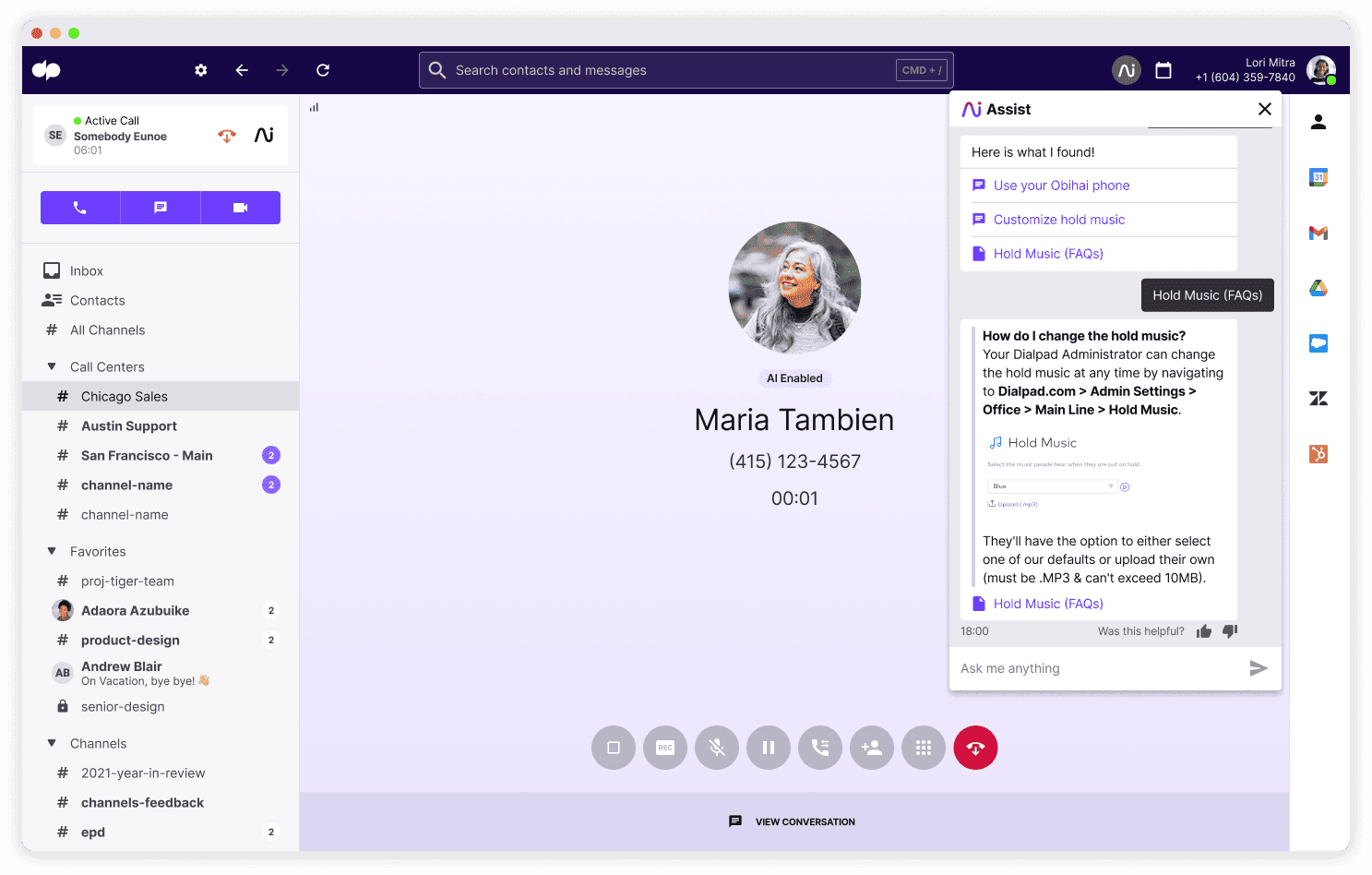
As a sales rep, I can still get the information needed to handle any tricky questions prospects throw at us, while still sounding authentic, informed, and engaged!
Now that we’ve reviewed some tips on preparing for a sales call, here are some ways to ensure you win during the process.
7 sales call tips from prospecting to closing
1. Start with a personalized intro and an agenda
Every successful sales call starts with a great first impression. People respond best when you show interest in them, so take time to build rapport before starting your pitch.
Use your research to personalize your introduction. This can be as simple as using your lead's name, but it can also be congratulating them on a recent promotion or mentioning a shared interest. Don’t get too personal, though一stick to the info you'd find on their company website, not their personal social media profiles.
Active listening is crucial for remembering the details from your sales conversation. In my experience, it’s much harder to do active listening if you’re busy jotting down or typing notes.
After the introduction, you should go through your proposed agenda so everyone knows what to expect from the call. But be sure to ask if your prospect agrees with it—they might have their own ideas of what they want to discuss too.
2. Back up wins and claims with data
You should always support claims about your company or product with facts. These can be customer stories, press releases, metrics, and other sources that you can point to in order to build credibility with your prospect.
You might also have a past customer who can be a referral and vouch for you here—it’s not uncommon for companies selling enterprise solutions to use these referrals when pitching a prospect in a similar industry. Be able to back up the claims that your company knows how to deliver and address the customer’s needs!
3. Use objections to get more information
A vital part of sales training is knowing how to handle common sales objections as mentioned above. My advice? Turn them into opportunities by asking targeted questions.
For instance, if someone says, “We like your product, but it’s too expensive for our budget," try looking beyond that initial objection and see if they have a budget in mind—if your solution can help them save money in the long run, bring that up! They might only be looking at the initial price tag and not understanding the long-term benefits.
4. Follow your sales playbook
In relatively mature sales organizations, your coach or supervisor will probably have trained you on a sales methodology that everyone on your team follows, like BANT, SPIN, or SPICED. There's a good reason for this, and for most sales reps, following these sales methodologies consistently will help you hit your numbers (and earn your commission).
One thing that's great about Dialpad is the Ai Playbooks feature. Using real-time speech recognition and generative AI, it lays out the questions that you need to ask during sales calls for the methodology your sales org uses and checks it off on your screen once you've asked them. It's great because whether you're a newer rep or a seasoned one, you have that reminder that helps with adherence and lets you know what you need to work on—before your manager even comes to you with that feedback:
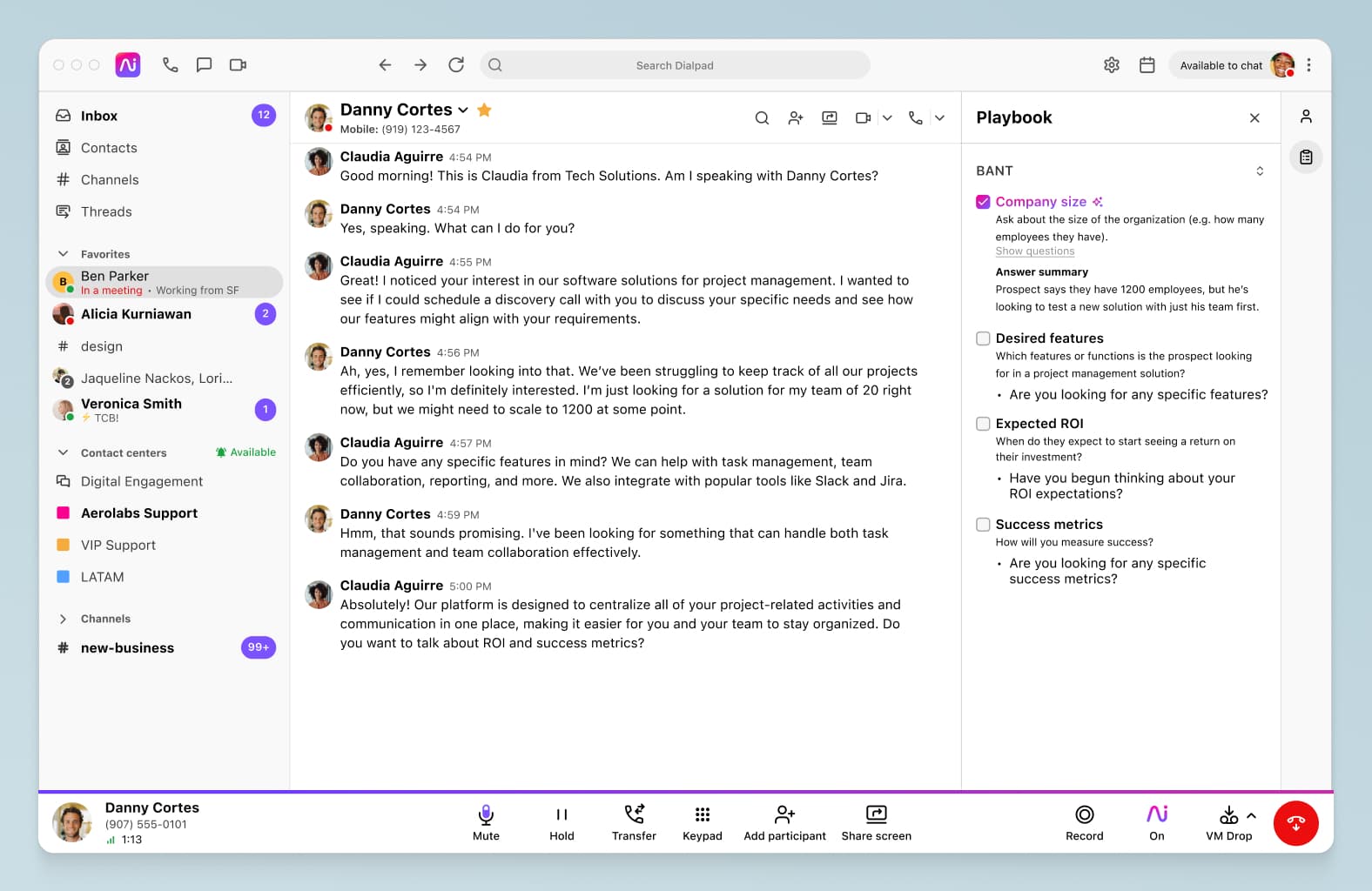
5. Wrap up the call by summarizing the main points of the discussion
I’ve found that the best phone sales technique for closing a call is Summarize, Bridge, and Pull (SBP). SBP has three parts:
Summarize the discussion, putting the prospect’s position before yours (remember: selling should be You/I, not I/You).
Ask if they agree with your summary or if there is anything else to add.
Propose the next step. For example, if you’re wrapping up a discovery call, the next step is probably a demo call.
SBP is the best way to stay in control of a deal and steer the sales process in the direction that’s best for your company.
6. Discuss the time and date of follow-ups
You should discuss the precise date and time of follow-ups. Don’t finish with a vague “I’ll call you next week," but propose an exact time, such as “I’ll call you next Thursday一how does 10am sound?”
You should also discuss action items. These are the actions you, the prospect, or other decision-makers need to take (and when). Sales AI tools like Dialpad can detect and record these action items, so you don't have to remember a long list of tasks.
👉 Dialpad tip:
A common action after a call is sending the buyer a summary of the key points you discussed. AI software makes this easy. For instance, Dialpad’s call summary feature compiles a call transcript, action items, and notes into an email that automatically gets sent to everyone on the call after it ends.
7. Record the call for further review and the prospect’s reference
My final tip for sales calls is to record the call for future reference. By reviewing the call, you can immediately see what went well and what you can do better. You can also plan what to cover in the next call.
With an AI sales coach like Dialpad, you can create playlists of the best sales calls to train your fellow reps. You can also send the voice transcription to your customer for their review and future reference.
Start having better sales calls
By using these sales calling tips, you and your prospects can have more effective sales calls一especially when you embrace technology.
Platforms like Dialpad provide detailed insights into your customers and performance. As such, they can elevate your success and improve productivity.
Most importantly, technology lets you give prospects your full attention. And that’s the best way to build rapport and close deals.
See how Dialpad Ai Sales Center works
Get a personal walkthrough of Dialpad's unique AI-powered platform, and see how our own Sales team uses it every day!








